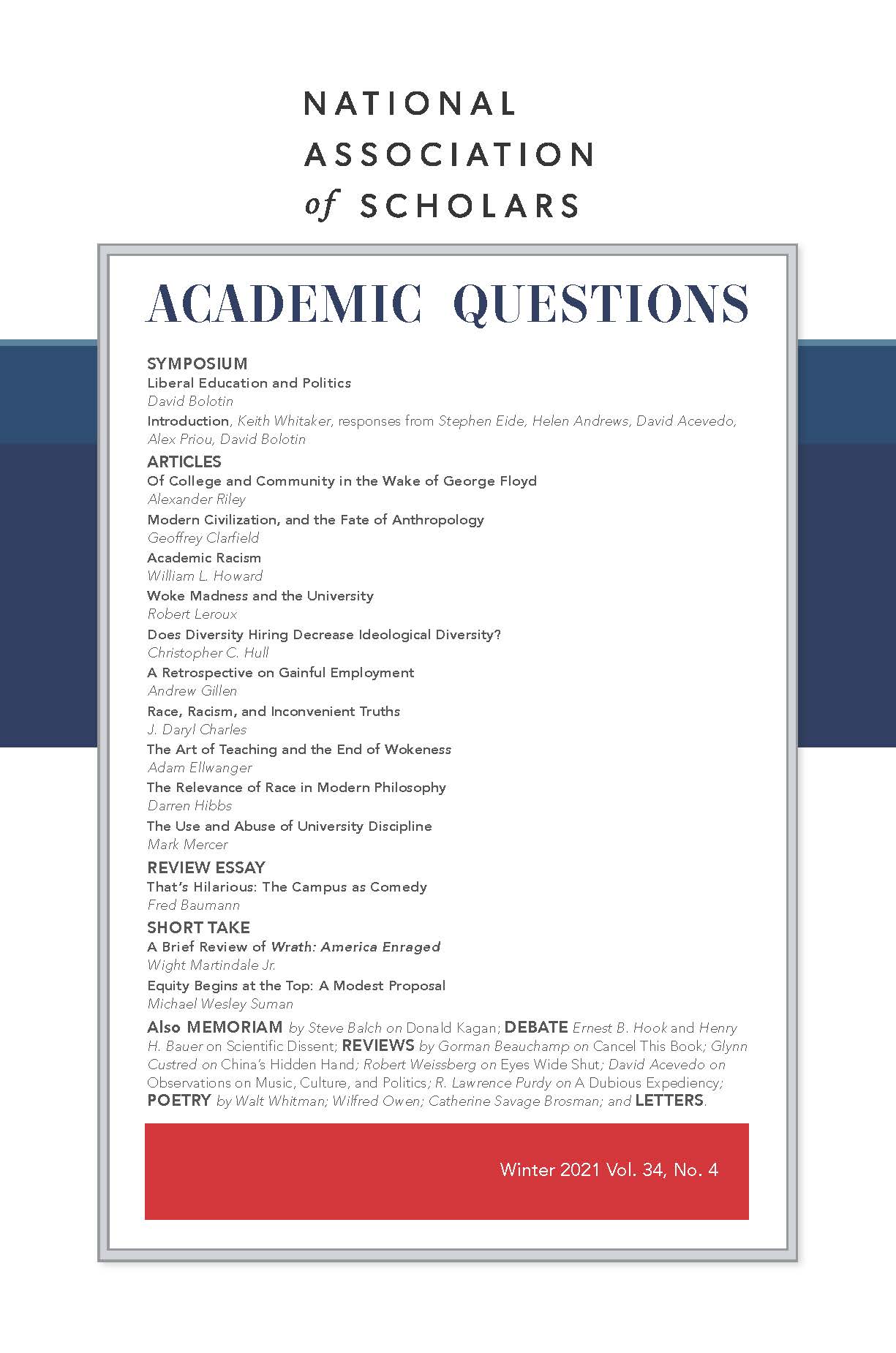To the Editor:
Seth Forman’s review of my book, Let’s Be Reasonable: A Conservative Case for Liberal Education Reasonable (“A Conservative Prof. Sees the Enemy . . . And it is Us!,” AQ Fall 2021), contains, amid some fair criticism, an error. The error occurs when Forman offers an example of how I “[strain] credulity to downplay the size and scope of the political monoculture that has seized higher education.” Forman says, “Comparing the percentage of faculty on the left with those on the right, for example, Marks reports, ‘At all institutions surveyed, that disparity is 59.8 percent to 40.2 percent.’”
Seth Forman’s review of my book, Let’s Be Reasonable: A Conservative Case for Liberal Education Reasonable (“A Conservative Prof. Sees the Enemy . . . And it is Us!,” AQ Fall 2021), contains, amid some fair criticism, an error. The error occurs when Forman offers an example of how I “[strain] credulity to downplay the size and scope of the political monoculture that has seized higher education.” Forman says, “Comparing the percentage of faculty on the left with those on the right, for example, Marks reports, ‘At all institutions surveyed, that disparity is 59.8 percent to 40.2 percent.’”
But if you go back to the passage Forman cites, you’ll find that I’m not comparing the percentage of faculty on the left with those on the right in the snippet Forman provides. Here is the quotation in its entirety:
At nonsectarian private colleges like mine, according to the 2016–17 Higher Education Research Institute Faculty Survey, just 10.7% of professors consider themselves conservative, and another 0.5% say they’re on the far right. We’re outnumbered by the 13.8% of faculty who put themselves on the far left, not to speak of the 50.5% who consider themselves liberals. Even if you combine “middle of the road” faculty with self-identified conservatives and far-rightists, that combination is still greatly outnumbered by the far left-liberal contingent, 64.3% to 35.7%. At all institutions surveyed, that disparity is 59.8% to 40.2.
So when Forman goes on to say that “one needn’t consult a survey to know the basic parameters of the left-right ideological imbalance of college faculty: it is not 60-40,” he isn’t responding to anything I’ve said.
This mistake is surprising, since I also write about the “overwhelming left-liberalism” of our campuses and say that speech on many of those campuses “approximates in some subject areas the discourse of a one-party state.”
Despite all that, I argue, just as Forman says, that there are also reasons to be hopeful about what conservatives can accomplish in higher education.
Jonathan Marks
Collegeville, Pennsylvania
Seth Forman responds:
The Higher Education Research Institute’s faculty survey cited by Jonathan Marks in his book Let’s be Reasonable provides a range of ideologies, with “Liberal” and “Far Left” furthest to the left (“Far Left,” “Liberal,” “Middle-of-the-Road,” “Conservative,” and “Far Right”). As a technical matter, any analysis that groups “Far Left” and “Liberal” for comparison against all the other categories, as Marks has done, by definition, must be a “left-right” comparison. If Marks would prefer that I described his analysis as “left-all others” rather than “left-right,” let the record stand corrected. The point is the same: anyone who reports that a full 40 percent of college faculty can reasonably be categorized as something other than “Liberal” or “Far Left” is badly mistaken.
If there was an error, it was Marks’s grouping of “Middle-of-the-Road” faculty with faculty on the right to underscore the ideological imbalance of college faculty. It is well-known that survey research on faculty politics suffers from “referent bias,” which renders categories such as “Middle-of-the-Road” meaningless outside the context of the left-leaning university. As a leading researcher recently told me “if a large share of your colleagues vote for Bernie Sanders, then you are ‘moderate’ if you vote for Elizabeth Warren.”
This is why the best research uses “anchor” questions, such as “I voted for Trump” or “I voted for Sanders,” very clear benchmarks upon which a faculty member’s political viewpoint can be gauged. When Gary Tobin and Aryeh Weinberg did this in 2004, they found that 68 percent of faculty who described themselves as “moderate” voted for John Kerry in 2004. Indeed, they found that 8 percent of faculty who described themselves as “conservative” or “very conservative” voted for Kerry.1
Given that Eric Kaufmann’s 2021 landmark study, which I reviewed along with Marks’s book, found that only 4 percent of U.S. faculty voted for Donald Trump in 2016, what does the “Middle-of-the-Road” category of the HERI survey really tell us? It tells us there are a lot of Hillary voters among U.S. faculty who call themselves “Middle-of-the-Road.”
I wrote in my review that Marks acknowledges the left-wing dominance of universities, and that he concedes “there is ‘a great deal of absurd political correctness at universities.’” But he also “strains credulity” to demonstrate, as he writes, that many “conservatives overestimate the extent and the depth of the problem.”
Uncritically reporting the flawed HERI survey is only one, albeit small, way in which he appears to do this. I take Marks’s word that he didn’t combine “Middle-of-the-Road” faculty with the right-leaning political categories in order to render the political imbalance among faculty seem less severe. But in a book in which “persuading conservatives” that universities are not under the thumb of a progressive oligarchy is "a goal near to my heart,” the effect was the same.
Seth Forman
Managing Editor
Academic Questions
1 Gary A. Tobin and Aryeh K. Weinberg, A Profile of American College Faculty, vol. 1, Political Beliefs and Behavior (San Francisco: Institute of Jewish and Community Studies, 2006).













